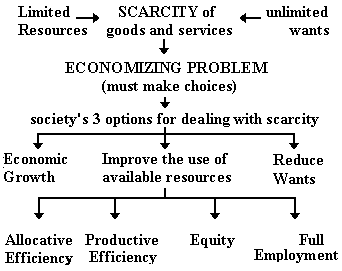 |
OPTIONAL: http://www.colorado.edu/Economics/courses/econ2020/section7/section7-main.html
Here are examples of the types of news articles that you should better understand after completing this chapter: :
- Confidence Surges in May
- GDP Slows, Labor Costs Up
- 4Q Productivity Jumps
- German GDP Grows 0.7%
- Business: The Economy OPEC slashes oil production
- U.S. urges Japan to take bolder economic steps
In this chapter we will study a tool that we can use to better understand these news articles.
Macroeconomics vs. Microeconomics
We have defined economics as the study of how we choose to use limited resources to obtain the maximum satisfaction of unlimited human wants
Macroeconomics Issues
The issues discussed in macroeconomics are:
1. full employment
2. price stability
3. economic growth
We have already discussed the importance of these topics in reducing scarcity and receiving the maximum satisfaction possible from our limited resources.
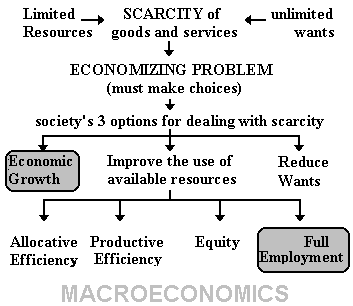 |
The Business Cycle
Over time the levels of unemployment (UE), inflation (IN) and economic growth (EG) in an economy tend to fluctuate. These fluctuations can be illustrated on a graph of the business cycle.
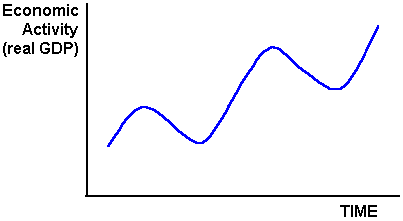
READ: http://www.acs.ucalgary.ca/~jwhunter/Social9/lesson_15.htm
Read: http://www.digitaleconomist.com/bc_4020.html
1. Economists have given terms to the four phases of the business cycle:a. #1 = peak
b. #2 = recession
c. #3 = trough
d. #4 = recovery
During each phase of the business cycle the macro-economic issues (UE, IN, and EG) change in a particular way:
Peak:
During the peak of the business cycle economic activity (output) is at its highest, therefore unemployment is very low, but inflation is high.Recession:
During the recession economic output declines ( a recession is defined as six months of declining output), therefore unemployment is rising and inflation is declining.Trough
During the trough economic output is is at its lowest, therefore unemployment is at its highest and inflation at its lowest.Recovery:
During the recovery economic output increases, therefore unemployment is declining and inflation is rising.The primary causes of the changes in output reflected in the business cycle are changes in spending. This could be changes in consumer spending (C), government spending (G), business spending on new capital (I), or purchases by foreigners Xn).
Notice that even though economic activity historically has been cyclical there is a secular trend upward over time (see red arrow in the graph below). Notice the each successive peak is higher than the previous peak.
In the twentieth century there were 20 recessions in the United States.
The last recession ended in 1991 and we are currently we are in the longest recovery ever. Will there be another recession? According to economic history we should expect one -- but when?
OPTIONAL: Table listing dates and length of business cycle recessions and recoveries - http://www.nber.org/cycles.html
A Model of the Macro Economy: Aggregate Demand (AD) and Aggregate Supply (AS)
We have already discussed the Supply and Demand model to determine individual prices and quantities. That was a microeconomic model. the key word is "individual" product or "Individual" industry.In macroeconomics we study the whole, or "aggregate" economy. Our new AGGREGATE supply and AGGREGATE demand model looks similar to the supply and demand model, but they are NOT the same! We are now discussing the whole economy, so AD is the demand for all products in an economy and AS is the supply of all products.
|
|
|
|
|
|
Definition
Aggregate demand is the demand of all products in an economy - OR the relationship between the Price Level and the level of aggregate output (real GDP) demanded.
Be able to define:
- Aggregate Demand
- Real Domestic Output (RDO) which can be measured by real GDP
- real GDP
- Price Level
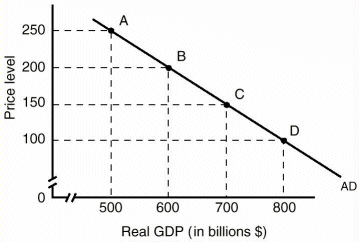
Graphically: down-sloping -- why?

Economists have three explanations of why the AD curve is downward sloping from left to right. They are:
We want to understand why if the Price Level increases why does the amount of aggregate output (real GDP) demanded decrease? Why is the AD curve downward sloping from left to right?
We always want to understand why the graphs that we use in economics have the shapes that they do? Are their shapes realistic?
The wealth effect:
When the average level of prices in the economy increases, why do consumers, governments, business and foreigners purchase less?One reason is the wealth effect. When the price level in the economy increases what happens to the real value, or the purchasing power, of financial assets (of money you have saved) and why do we then buy less?
Price Level Þ real value of financial wealth ? Þ Amount of output demanded ¯
Well, when the
Price Level Þ real value of financial wealth ¯ Þ Amount of output demanded ¯because they now have less real wealth.
The interest-rate effect:
When the average level of prices in the economy increases, why do consumers, governments, business and foreigners purchase less?Another reason is the interest rate effect. When the price level in the economy increases what happens to the interest rates and why do we then buy less ?
Price Level Þ interest rates ? Þ Amount of output demanded ¯
Well, when the
Price Level Þ interest rates Þ Amount of output demanded ¯because people will buy less of those things for which they have to borrow money.
The foreign purchases effect :
When the average level of prices in the economy increases, why do consumers, governments, business and foreigners purchase less?The third reason is the foreign purchases effect. When the price level in the US economy increases what happens to the relative prices of foreign products and why are fewer American products purchased ?
Price Level Þ relative price of foreign products ? Þ Amount of output demanded ¯
Well, when the
US Price Level Þ relative price of foreign products ¯ Þ Amount of US output demanded ¯because people will now buy more of the now relatively cheaper foreign products.
Changes in AD
Just like with supply and demand in the individual product market, there are determinants that will shift the AS and AD curves. These determinants are the REAL WORLD EVENTS that cause the graphs to shift. remember, that our goal is to better understand what causes the business cycles -- or what causes UN, IN, and EG to change.
|
(shifts to the right) |
(shifts to the left) |
|
|
|
Just like with demand in the individual product market, there are determinants of AD that, if they change, will shift the AD curve. They are:
Summary of the determinants of AD:
C Þ
AD C ¯ Þ¯
AD I Þ
AD I ¯ Þ¯
AD G Þ
AD G ¯ Þ¯
AD Xn Þ
AD Xn ¯ Þ¯
AD MS Þ ¯
Interest Rates Þ
I
Þ AD MS ¯ Þ
Interest Rates Þ
I ¯
Þ¯ AD T ¯ Þ
C Þ
AD T Þ ¯
C Þ ¯
AD S ¯ Þ
C Þ
AD S Þ ¯
C Þ ¯
AD
But what causes these things to change? Well, economists have identified some determinants of the main components of spending: C, I, G, and Xn.
Determinants of C, I, G, and Xn:
C = consumer spending (and saving)
- consumer wealth
Wealth Þ C Þ AD
- consumer expectations
Expected future Income Þ C today Þ AD today
- consumer indebtedness
Consumer Debt Þ ¯ C Þ ¯ AD
- taxes
T Þ ¯ C Þ ¯ ADI = investment spending
- interest rates (money supply)
MS Þ ¯ Interest Rates Þ I Þ AD
- profit expectations on investment projects
profit expectations Þ I Þ AD
- business taxes
Business Taxes Þ ¯ I Þ ¯ AD
- technology
technology Þ I Þ AD
- degree of excess capacity
excess (unused) plant capacity Þ ¯ I Þ ¯ AD
G = government purchases
Xn = net export spending
- net income abroad
Income in Foreign Countries Þ Xn Þ AD
- exchange rates
value of the $ Þ ¯ Xn Þ ¯ AD
Definition
Aggregate Supply is the supply of all products in an economy - OR the relationship between the Price Level and the level of aggregate output (real GDP) supplied.
Graphically
Graphically, we would expect the AS curve to be upward sloping. If business expect that they can get a higher price for their products (higher price level) they will want to produce MORE. But, remember that the price level is the average level of ALL prices in the economy, therefore, if the price level increases, the price of resources will also increase. Higher resource prices will encourage businesses to produce LESS. So maybe the As curve should be downward sloping????Some economists graph the AS curve like this to handle this problem:
Shape
We can identify three different parts, or ranges, to the AS curve:1. Keynesian (horizontal) range
2. classical (vertical) range
3. intermediate (up-sloping) range
In the Keynesian or horizontal range the level of output in the economy is low. Very little is being produced so there are a lot of resources not being used. Business are then able to produce more output without having to pay more for the additional resources. Since many resources are unemployed, businesses will not have to pay a higher price to employ them. Therefore, they can produce more without having to raise the price (note how the price level is constant in the Keynesian range of the AS curve).
In the Classical or vertical range of the AS curve there are no more resources available. ALL are being used. So all business together cannot produce any more since there are no more resources to use. But, if some business try to produce more by enticing resources away from other business with higher resource prices (higher wages for example) whey will have to raise their prices to cover the higher costs - BUT the amount produced will stay the same since no additional resources are being used. So, the AS curve is vertical indicating no additional output even at higher price levels.
I n the intermediate range the As curve begins to rise slowly as a few resources begin to run out and at higher levels of output the AS curve becomes steeper as the economy runs out of even more resources, until it is vertical when all resources are being used and it is not possible to produce any more output.
Aggregate Supply and Full Employment
If we want to use the AS-AD model to better understand the macroeconomic issues of UE, IN. and EG, then we need to be able to locate the "full employment level of output" - the amount of GDP that can be produced if all resources are being used.You would think that this would occur where the AS curve is vertical, but what do we really mean by "full employment"? Does this mean all resources, including labor, working everyday day for as many hour as is physically possible? Or does it mean "full employment" under "normal" conditions where people work maybe 40 hours a week? They retire at age 65 and don't begin to work until age 18 or 22? If this is our definition of "full employment", then it would be possible to produce more than the full employment level of output by having people work 50, 60, 70, 80, or even more hours a week. People could never retire and just keep working until they die. Etc. If this happened then MORE would be produced. But his isn't really what we mean when we say "full employment". Therefore, it is possible to produce more than the "normal" full employment level of output.
The graph below shows how we can illustrate this level of output under normal conditions of full employment.
Note that at higher levels of output the price level increase dramatically resulting in high inflation, therefore some people define the full employment level of output as the amount of output that can be produced and still maintain low inflation.
Increase and decrease in AS
Increase in AS
(shifts to the right)Decrease in AS
(shifts to the left)
Determinants of AS
Just like with supply in the individual product market, there are determinants of AS that, if they change, will shift the AS curve. They are:a. change in input prices
price of resources Þ ¯ AS1) labor
2) land (OPEC)
[OPTIONAL: http://news.bbc.co.uk/hi/english/business/the_economy/newsid_300000/300492.stm]
3) capital
4) entrepreneurial abilityb. changes in the productivity of resource
productivity Þ ASBe sure to know the difference between:1) Productivity
- output per unit of resource
2) production
- the quantity produced
3) productive efficiency
- producing at a minimum cost (5 Es)c. legal-institutional environment
business taxes and gov't red tape Þ ¯ AS1) business taxes and subsidies
2) government regulation (red-tape)
Summary of the Determinants of AS
price of resources ¯
Þ AS price of resources
Þ ¯AS productivity Þ
AS productivity ¯ Þ
¯AS business taxes and gov't red tape¯
Þ AS business taxes and gov't red tape
Þ ¯AS
Equilibrium
You can use the AS-AD graph to find the equilibrium price level and the equilibrium level of output:
In this economy the level of real domestic output (real GDP) will move toward RDO1 and the price level will move toward PL1.
Changes in AD and the Macroeconomic Issues
The reason we have developed the AS-AD model is to better understand UE, IN, and EG.
Employment
If the equilibrium level of output is below the full employment level as in the graph above the result is unemployment.
Inflation
Demand-pull inflation is inflation caused by an increase in AD. As you can see on the graph below, if there is an increase in AD the price level increases. Inflation is the rate of increase in the price level.
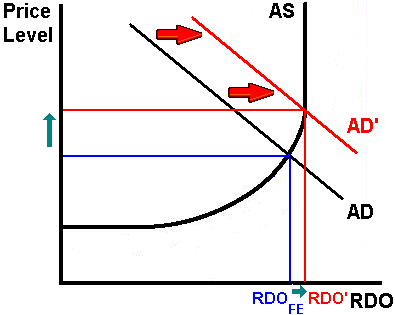
A decrease in AD will cause the level of output to decline indicating\ higher unemployment.
But what happens to the price level? Normally we would expect the price level to decline from PL to PL' if AD decreases, but can you remember a time when the price level (the average level of ALL prices in the economy) decreased? It doesn't happen very often. Business are more willing to raise their prices (causing more inflation) than they are to decreases their prices (causing deflation). Economists call this the ratchet effect. Like a ratchet that only works in one direction, prices mores easily move in one direction (up) than in both. Sometimes it is said that prices are "stick downwards".
On the graph then, if AD decreases instead of going from "a" to "b" (less output and a lower price level), the economy goes from "a" to "c" since prices are sticky downwards and tend not to decrease. therefore the price level stays the same (at PL), but the level of output drops even more (from RDO-FE to RDO2 instead of only to RDO1).
The causes of the ratchet effect are listed below. For several reasons businesses are reluctant to lower prices even when faced with lower aggregate demand.
a) Wage contracts often mean that businesses have to increase their costs even if AD decreases.b) If businesses lower wages so that they can lower their prices, this may have an adverse effect on morale and productivity
c) If businesses lower wages so that they can lower their prices, they may lose some of best workers in which they have invested much in training
d) To lower their prices business would like to decrease their labor costs (wages), but they may not be able to because of the minimum wage laws.
e) Finally, businesses may have monopoly power, giving them more control over their prices and they may choose to take smaller profits rather than lowering their prices.
Changes in AS and the Macroeconomic Issues
A decrease in AS would decrease output and raise the price level. This would result in more unemployment and more inflation. We call this inflation "cost-push" inflation. It is inflation caused by a decrease in AS.
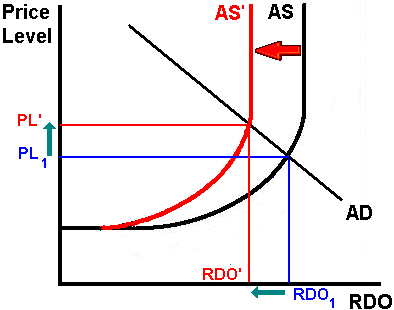
Stagflation
A decrease in AS results in "stagflation". Stagflation is a decrease in output (an increase in unemployment) accompanied by an increase in inflation - a STAGnant economy with inFLATION. It is caused by a decrease in AS.
An increase in AS would increase output and lower the price level. This would result in less unemployment and less inflation.
Economic Growth
What about economic growth? In an earlier lesson we discussed three definitions of economic growth
- Increasing our POTENTIAL OUTPUT
- Increasing Output, and
- Increasing Real GDP per capita
(1) Increasing our POTENTIAL OUTPUT
I like to call this increasing our ABILITY to produce. This is the definition we used in the 5 Es lesson. This is the most fundamental definition of economic growth. It is the type of economic growth used on our 5 Es diagram.
We can increase our ABILITY to produce goods and services (or increase our POTENTIAL GDP) if we get:
- more resources
- better resources, and
- better technology
Since this increases maximum output that we are able to produce it shifts the PPF outward. On the graph below, economic growth would cause the PPF to move from PP1 to PP2.
This doesn't necessarily mean that the economy IS producing more, just that it CAN produce more. To achieve our new potential levels of output we also need full employment and productive efficiency. It could be possible to have this type of economic growth so that we CAN produce the quantities represented by point E, but if there is unemployment and productive inefficiency we would be at a point beneath this new curve (maybe point C). So we may get new resources or new technology so we CAN produce more (point E on PP2), but if we don't use the new resources (i.e. we have unemployment) or if we don't use the new technology (i.e. we have productive inefficiency) , we may remain on PP1 (point C).
In the AS-AD model INCREASING OUR POTENTIAL OUTPUT is represented by in increase in AS.
Notice that when AS increases, the full employment level of output increase from RDO-FE1 to RDO-FE2. this is an increase in our potential level of output.
In the 5 Es lecture we said that economic growth is caused by:
- more resources
- better resources, or
- better technology
An increase in the production possibilities curve is caused by having more resources, better resources, or better technology.
An increase in AS is caused by:
- a decrease in the price of resources
- an increase in productivity
- lower business taxes and government red tape
These are all really the same thing.
(2) Increasing Output
The most commonly used definition of economic growth is simply producing more. (Later we will call this INCREASING REAL GDP.)When an economy increases its output it is often said to have achieved economic growth. But if by producing more we are simply ACHIEVING OUR POTENTIAL, then we could also say that it is REDUCING UNEMPLOYMENT or ACHIEVING PRODUCTIVE EFFICIENCY. On our graph this would be represented by moving from point D to a point on the curve: A, B, or C).
On our AD-AS model we could illustrate this type of growth (producing more) by an increase in AD.
Notice that output increase from RDO-EQUIL to RDO', but the full employment level of output, which is our potential level of output, does not change (RDO-FE).
If Ad increase so that equilibrium is at the full employment level of output, it is analogous to going from a point inside the production possibilities curve to a point on the curve.
(3) Increasing Real GDP per capita
The definition of economic growth used in our multimedia lesson on economic growth (Macro_015.les) is an increase in GDP per capita. This means increasing output per person. GDP per capita is calculated by dividing output by the population.
Now that we have introduced the AS / AD model, let's learn how to use it.
EXAMPLE 1
Read this short article from cnnfn.com. Analyze the article by identifying the determinants of AD and/or AS that have changed. Then graph the changes on the AS-AD model. Finally use your graph to discuss has happened to UE, IN, and EG.
German GDP grows 0.7%
Export increase lifts economy; OECD raises estimate of growth rate
May 30, 2000: 7:08 a.m. ET
LONDON (CNNfn) - German first-quarter gross domestic product increased 0.7 percent from the previous three-month period, as expected, helped by demand for exports, the Federal Statistics Office said on Tuesday.
The German economy, Europe's biggest, expanded by 3.3 percent in the first quarter of 2000 compared to the same period a year ago, the strongest annual rate of growth since the first quarter of 1998.
The quarter-over-quarter growth rate matched the 0.7 percent pace recorded in the three months ended Dec. 31, aided by a decline in the euro that has made exports cheaper. Economists now predict full-year growth of more than 3 percent.
"It's a very good start to the year 2000 and clearly indicates the upswing is intact and growth is accelerating," said Manuela Preuschl, an economist at Deutsche Bank in Frankfurt.
The Organization for Economic Cooperation and Development Tuesday raised its forecast for German economic growth, predicting GDP would rise 2.9 percent this year and 3 percent in 2001, as exports remain strong and tax cuts boost domestic demand.
In the first quarter, exports grew 15.3 percent from a year earlier while imports rose 11.9 percent. Gross investment in plant and equipment increased 5.7 percent. The pace of growth in private consumption weakened to 0.9 from a year earlier, compared with 2.2 percent in the fourth quarter of 1999.
--from staff and wire reportsOriginal AS/AD graph:
Determinants that are mentioned in the article:
"German first-quarter gross domestic product increased 0.7 percent from the previous three-month period, as expected, helped by demand for exports, the Federal Statistics Office said on Tuesday."So: Xn Þ AD
ALSO:
"The Organization for Economic Cooperation and Development Tuesday raised its forecast for German economic growth, predicting GDP would rise 2.9 percent this year and 3 percent in 2001, as exports remain strong and tax cuts boost domestic demand."
So: ¯ Taxes Þ C Þ AD
Draw the changes on the graph: AD
What happened to UE, IN, and EG as a result of these changes?
Since equilibrium RDO increased from RDOequil to RDO' we can conclude that UE decreased and EC increased. The price level rose slightly from PL to PL' so maybe IN increased a little.
EXAMPLE 2
Read this short article from http://news.bbc.co.uk. Analyze the article by identifying the determinants of AD and/or AS that have changed. Then graph the changes on the AS-AD model. Finally use your graph to discuss has happened to UE, IN, and EG.
[http://news.bbc.co.uk/hi/english/business/the_economy/newsid_300000/300492.stm]
Wednesday, March 24, 1999 Published at 10:34 GMT
Business: The Economy
OPEC slashes oil production
Oil producers finally agree to restrict output
Ministers from oil producing countries have agreed to cut global production by 7% to bolster depressed oil prices.The members of the Organisation of Petroleum Exporting Countries (OPEC) and others meeting in Vienna have agreed to a reduction in output of 2.1m barrels a day until April next year.
. . . . . . .
OPEC wants to reverse the glut of oil on the market
Saudi Oil Minister Ali al-Naimi said the new restrictions were aimed at lifting oil prices back to $18 a barrel within a year.
. . . . . .
Inflation fears
However, this would hit consumers hard, perhaps rekindling inflation.
The oil price has increased 30% in the last month on the belief that OPEC would finally agree to cap output. Oil has risen from its low in December of below $10 a barrel, for Brent crude for May delivery, to $13.75 as the decision was announced.. . . . . . .
Original AS/AD graph:
Currently the economy of the United States is operating at the full employment level of output as shown in the graph below:
Determinants that are mentioned in the article:
"The oil price has increased 30% in the last month on the belief that OPEC would finally agree to cap output. Oil has risen from its low in December of below $10 a barrel, for Brent crude for May delivery, to $13.75 as the decision was announced."So: Price of resources Þ ¯ AS
Draw the changes on the graph: ¯ AS
What happened to UE, IN, and EG as a result of these changes?
Since equilibrium RDO decreased from RDO1 to RDO' we can conclude that UE increased and EG decreased. The price level will rise from PL1 to PL' indicating inflation. With output down and prices up, this increase in oil prices may result in stagflation.
EXAMPLE 3
Is an increase in exports good for an economy? Most students will quickly answer "yes" to this question, as would most newspaper writers. But WE know better. It depends.
Currently the economy of the United States is operating at the full employment level of output as shown in the graph below:
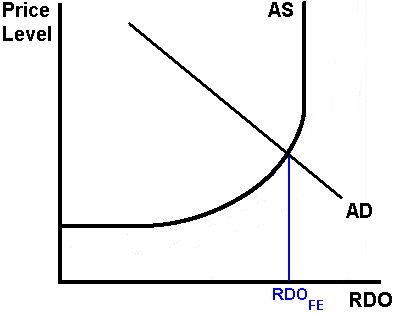
An increase in exports will do what to the graph above? An increase in exports will increase AD.
GRAPH IT!

The result: INFLATION! So is an increase in exports good for THIS economy? NO.
But, if initially the economy is experiencing high unemployment like in the graph below:
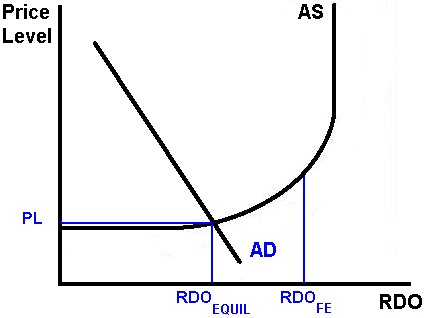
Then, an increase in exports would increase AD and move the economy closer to the full employment level of output with only a little inflation. See graph:
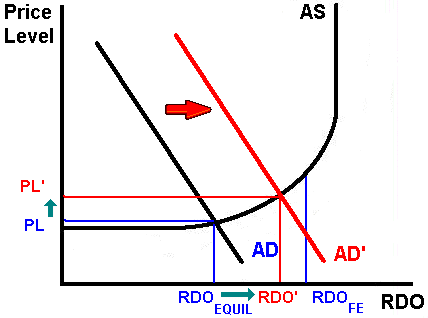
This would of course be good for the economy. So is an increase in exports good for an economy? - - It depends.
EXAMPLE 4
Now you try it. Read this short article from cnn.com. Analyze the article by identifying the determinants of AD and/or AS that have changed. Then graph the changes on the AS-AD model. Finally use your graph to discuss has happened to UE, IN, and EG. Send your answers to me using the form below.
http://cgi.cnnfn.com/output/pfv/2000/05/30/economy/confidence/
MORE EXAMPLES / REVIEW:
For more exercises see: http://www.harper.cc.il.us/mhealy/eco212i/lectures/asad/adasprac.htm
Now that we have this handy tool, let's use it to discuss government policies (NOTE: when I use the term "policies", I always mean "government policies"). What is the role of the government in a market economy? In a market economy (capitalist economy) the government has a limited role, but some people believe that the government should try to help the economy maintain full employment and low inflation. We have discussed in the 5 Es lesson that unemployment results in greater scarcity since some resources are not being used so less will be produced. Government policies may be able to help the economy achieve full employment and therefore reduce scarcity.
Stabilization Policies
Definition: government policies design to reduce UE and/or inflation All the policies discussed here can be classified as stabilization policies.There are two major types of stabilization policies:
- demand-management policies
- supply-side policies
Demand-Management Policies
Definition: Policies design to shift the AD curve in order to reduce unemployment or to reduce inflation.Tools -- Some of the determinants of AD can be manipulated by the government to achieve these goals.
There are two types of demand-management policies depending upon WHO conducts the policy:
- fiscal policy is undertaken by the president and the congress, and
- monetary policy is undertaken by the Federal Reserve Board (often called the "fed").
FISCAL POLICY
There are two types of fiscal policy:
- expansionary fiscal policy
- contractionary fiscal policy
The goal of expansionary fiscal policy is to reduce unemployment. Therefore the tools would be an increase in government spending and/or a decrease in taxes. This would shift the AD curve to the right increasing real GDP and decreasing unemployment, but it may also cause some inflation.
The goal of contractionary fiscal policy is to reduce inflation. Therefore the tools would be an decrease in government spending and/or an increase in taxes. This would shift the AD curve to the left decreasing inflation, but it may also cause some unemployment.
MONETARY POLICY
There are two types of monetary policy
- easy money
- tight money
The goal of an easy policy is to reduce unemployment. Therefore the tool would be an increase in the money supply. This would shift the AD curve to the right decreasing unemployment, but it may also cause some inflation.
MS Þ ¯ Interest Rates Þ I Þ ADThe goal of a tight money policy is to reduce inflation. Therefore the tool would be a decrease in the money supply. This would shift the AD curve to the left decreasing inflation, but it may also cause some unemployment.
MS ¯ Þ Interest Rates Þ I ¯ Þ¯ AD
"Supply-Side Economics"
Supply-Side economic policy occurs when the government tries to increase the AS curve. this will reduce both unemployment and inflation.
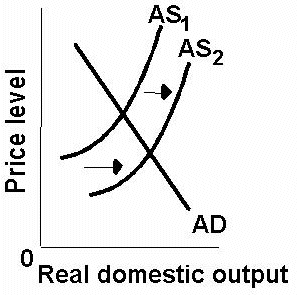
There are three determinants of AS:
a. change in input prices
price of resources Þ ¯ ASb. changes in the productivity of resource
productivity Þ ASc. legal-institutional environment
business taxes and gov't red tape Þ ¯ ASSupply-Side Policies
Supply-side policies try to increase productivity. Often this includes less government regulations. Also, in the 1980s President Reagan decreased marginal income tax rates as a supply-side policy (sometimes called "Reaganonmics"). The idea was that people will work more if they can keep more of their incomeWe have said that decreasing income taxes will INCREASE AD. But here we said that it may also INCREASE AS. Which is it? both may be true, but the effect on AD is probably quicker. In this class a tax cut will increase AD, UNLESS we mention that is is a "supply-side" tax cut. Then we will increase the AS curve.
REVIEW